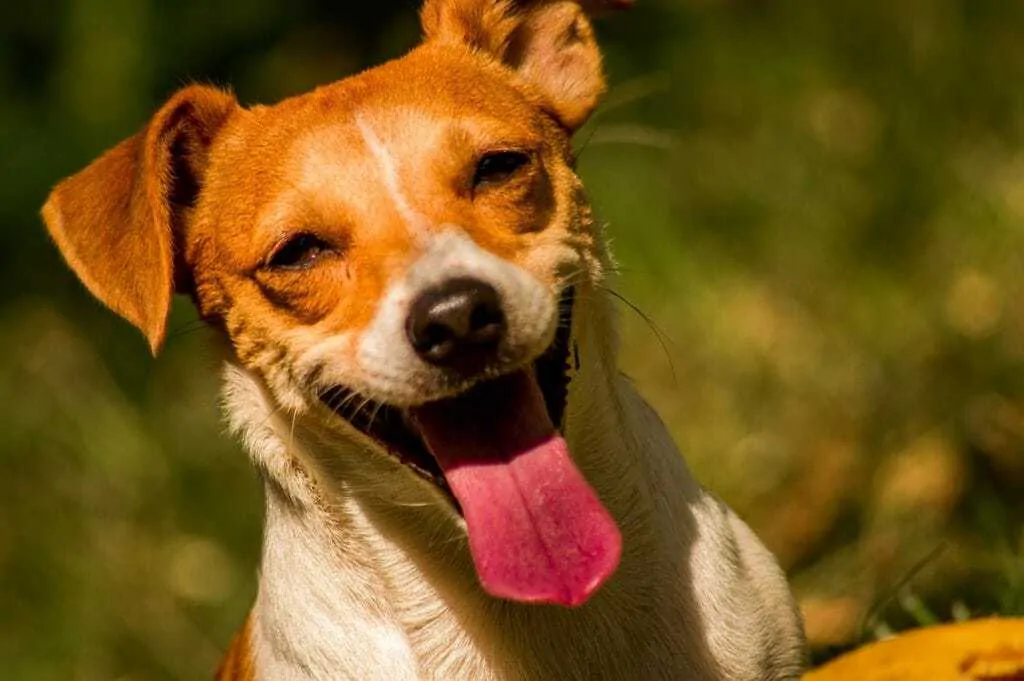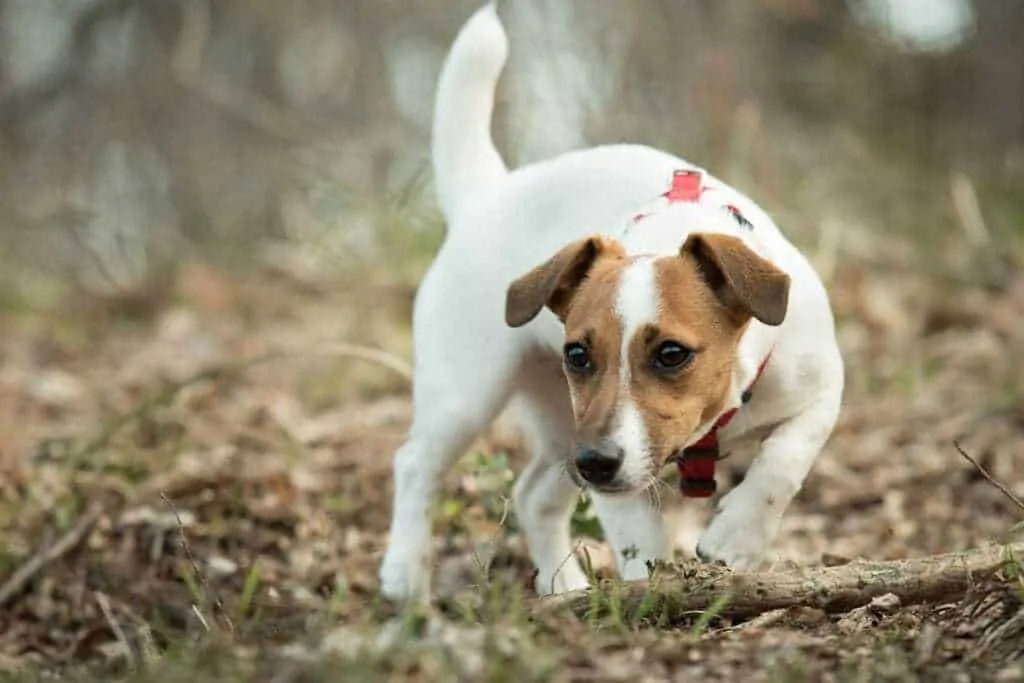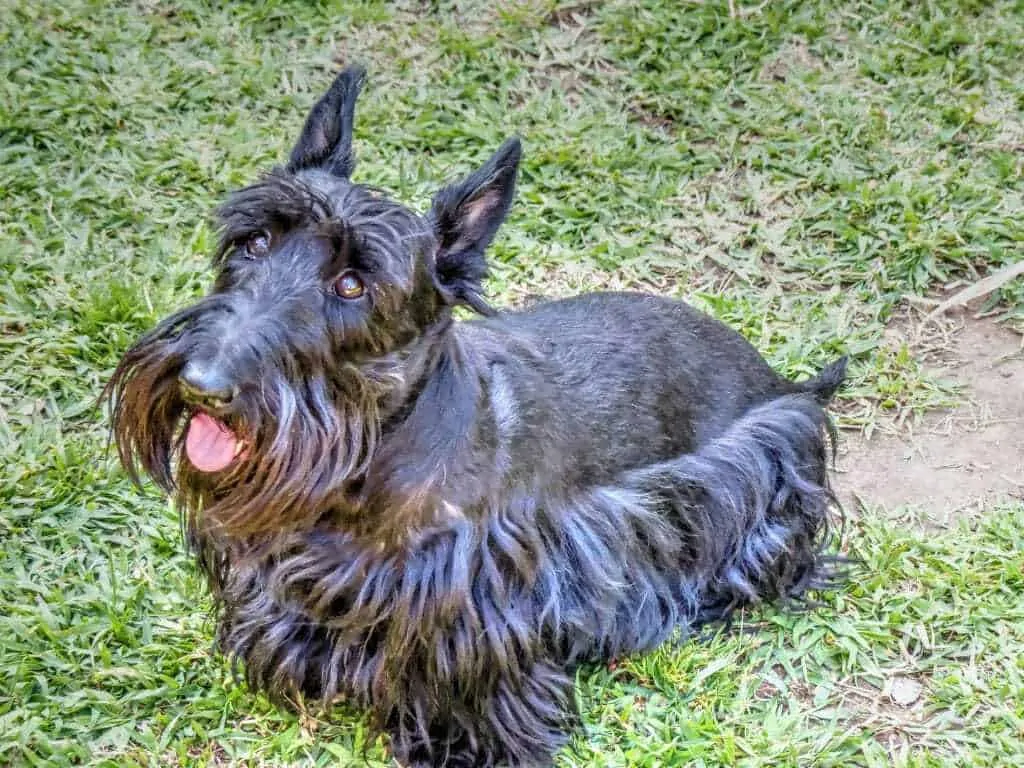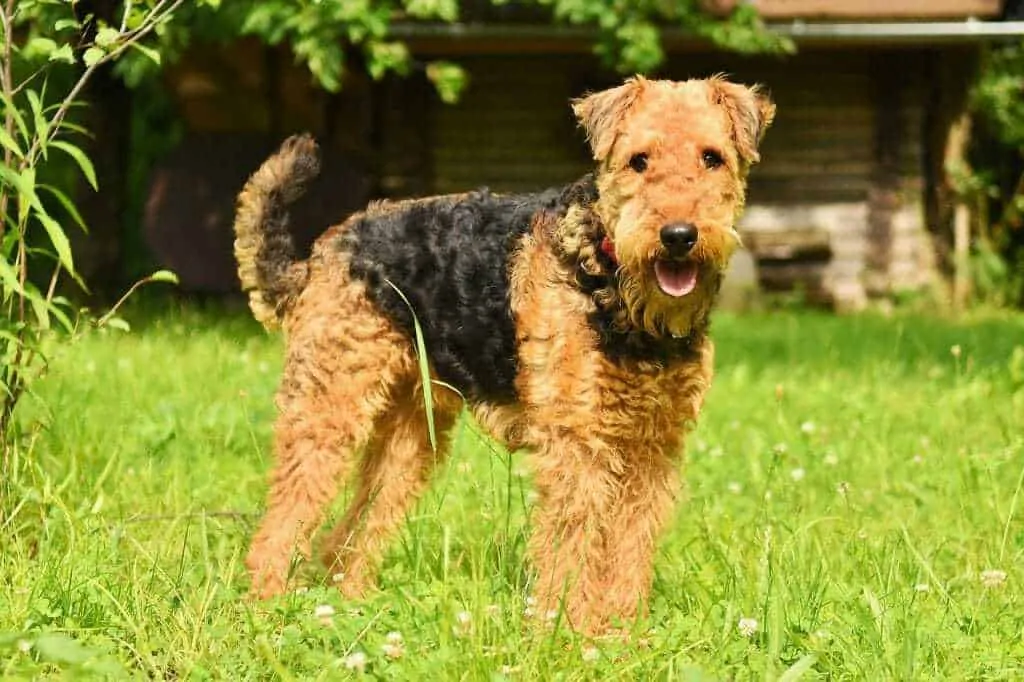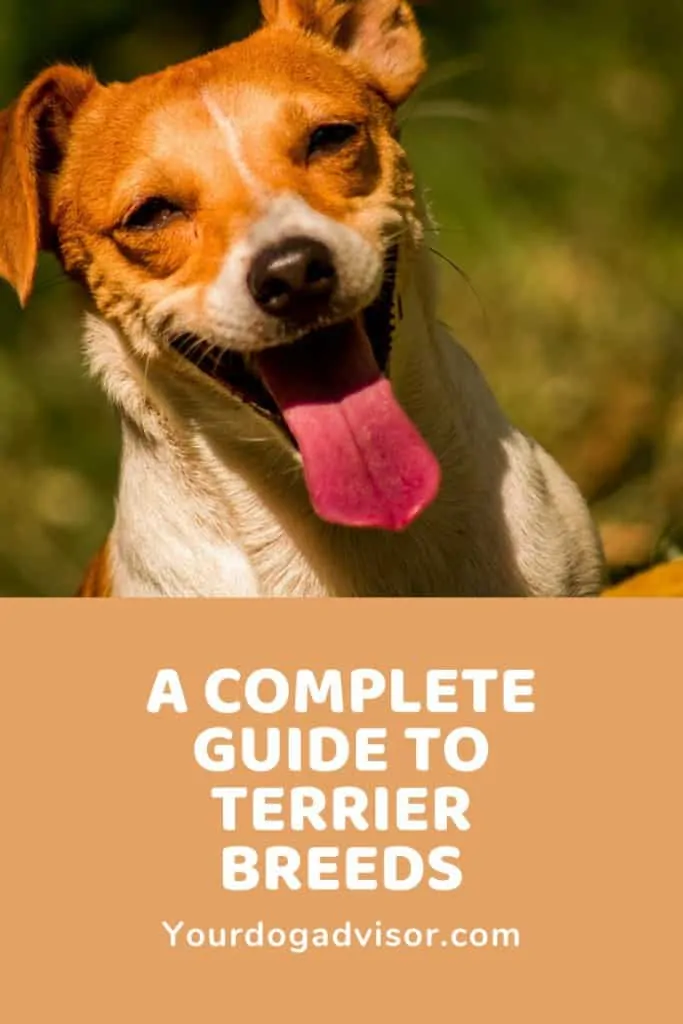When most of us think of terriers, we have a certain type of dog in mind. Those of us who have experience with the small terrier group will conjure up an image of a Yorkie or a West Highland White Terrier — feisty, fearless little dogs with a distinct stubborn streak. Medium-sized dog lovers might imagine a plucky Rat Terrier or a dependable little Scottie. And those who gravitate towards larger dogs might bring an Airedale or American Staffordshire Terrier to mind. From mini to majestic, terriers come in just about every shape and size. And that’s good news for dog lovers, because it means there is a terrier breed that will fit into almost anyone’s life.
When properly socialized and trained, terriers are typically happy, playful, affectionate dogs
Contents
The History of Terrier Breeds
The word “terrier” derives from the Latin “terra,’ which means earth. Historically bred as working dogs, terriers first appeared in the British Isles in the mid-15th century, where they were bred to hunt rodents by burrowing underground. Later, during the 18th and 19th centuries, these early terriers were crossbred with a variety of hounds and bulldogs to increase their hunting skills,courage and size. They were also selectively bred for “gameness” — the willingness to continue the hunt and/or fight despite the threat of significant injury. (These days, we often refer to this trait as “spunk”).
Early in their history, terriers were divided into only two groups: short legged and long-legged breeds.
- The short-legged breeds like the West Highland White Terrier and the Dandie Dinmont were designed for chasing small underground vermin like woodchucks and rats.Smart, independent, and agile, they have narrow bodies and strong forelegs meant for burrowing and holding down prey. They’re also equipped with a piercing, high-pitched bark that can be easily heard by their handlers above ground.
- Long-legged terriers like the Jack Russel and Border Terrier were also bred for hunting, but their prey were larger animals like badgers and foxes. With strong, straight forelegs and toes that point straight ahead,they are incredibly efficient diggers (good for flushing out foxes,not so good for your yard). Some of the larger long-legged breeds like the Airedale were also used for run-of-the-mill farm work such as herding and guarding livestock.
Then, in the late 1700s and early 1800s, aficionados of the blood sports of dog fighting and bull baiting set out to breed another type of dog.They crossed bulldogs (which were traditionally used for fighting) with terrier breeds to create dogs with the muscular build and powerful jaws of a bull dog and the agility and spunk of a terrier. These “bull terriers” were the ancestors of today’s Bull Terrier group, which includes the Staffordshire Terrier (named for the county where it first gained popularity), the American Staffordshire Terrier (AmStaff) and the Bull Terrier breeds.
The most recently introduced group of terriers are the toy terriers, such as the English Toy Terrier and the Yorkie. Although they are classified by the American Kennel Club as part of the “Toy Group” of dogs, these feisty, independent mini-dogs are definitely terriers at heart. Fearless and independent, these plucky little pooches will rarely back down, even in a face-off with a much larger dog.
Popular Terrier Breeds
Today, terriers are extremely popular pets both here in the U.S. and in the U.K.. And while it’s impossible to discuss every one of the several dozen breeds included in the terrier group here, let’s take a quick look at some of the most popular breeds and discuss why they make such terrific pets. (My apologies in advance if your favorite didn’t make the list!)
Russell Terrier (aka Jack Russell Terrier)
Breed At a Glance
- Energy Level: Very high
- Temperament: Happy, playful, stubborn
- Child friendly: Best with older children
- Exercise Needs: At least 30 minutes of brisk exercise/play time twice a day
- Grooming Needs: Low: Brush out rough coated dogs once a week
- Shedding: Low
- Health: Generally good
- Lifespan: 13 to 16 years
Small but muscular and highly intelligent, the Russell Terrier loves being outdoors and is always ready to chase small prey.
Named for the Rev, John Russel, an English parson who is credited with developing the breed, Russel Terriers are high-energy, compact dogs that typically stand between 10 and 12 inches tall and weigh about 15 pounds. (Its cousin, the Parson Russell Terrier, is a bit taller and heavier, and is recognized by the AKC as a separate breed.) Usually mostly white with tan, black or brown markings, they sport a double coat that may be smooth, broken or rough.Their triangle-shaped ears point downwards towards large, expressive, almond-shaped eyes, giving their faces a naturally inquisitive look. Rough-coated dogs also typically have shaggy eyebrows and a little goatee.
Initially bred as fox-hunting dogs, today’s Russel Terriers retain the independent nature and keen prey drive of their ancestors as well as a seemingly insatiable desire to dig. (You may want to give your dog a special place in the yard where he can practice this skill.) Playful and energetic, they make wonderful companion dogs, especially for people who enjoy the great outdoors.That said, they can be headstrong to the point of recalcitrance, so early obedience training is a must. Because they tend to be intolerant of rough handling, they do best in homes without young kids.
Border Terrier
Breed at a Glance
- Energy Level: High
- Temperament: Cheerful, affectionate
- Child friendly: Yes
- Exercise Needs: At least 40 minutes a day
- Grooming Needs: Medium: Brush once a week and “hand-strip” the dead, rough outer coat at least twice a year
- Shedding: Low
- Health: Generally good
- Lifespan: 13 to 15 years
The scruffy Border Terrier is considered one of the most social and easy-to-train of the terrier breeds.
My personal favorite of the terrier breeds, the Border Terrier is a smart, scrappy little dog with a sweet personality and a heart of gold. Extremely social and affectionate, Border Terriers are good with children of all ages and make wonderful family pets. Although they are quite energetic and have a bit of the typical terrier stubborn streak, they tend to be easier to train than other terrier breeds.
First bred in the hills bordering England and Scotland, Border Terriers are a hardy bunch. Their wiry double coat provides protection from the elements, and their loose pelt protects them from scratches and bites when hunting prey. Thanks to years of responsible breeding, they are usually quite healthy dogs too, and are not prone to the kinds of genetically linked illnesses that plague many other small breed dogs.
Although grouped with the long-legged terriers by the AKC, border terriers are small dogs, typically standing about 12 to 15 inches tall and weighing 11 to 15 pounds.Their coats are usually black and tan, red, wheat-colored or brown, often with a dark, wiry, grizzle on top. And while they generally are not considered one of the most attractive terrier breeds, their pleasant, friendly nature and high-intelligence more than make up for what they lack in looks.
Scottish Terrier
Breed at a Glance
Energy Level: Moderately high
Temperament: Solid, dependable, aloof with strangers
Child friendly: Yes, with family members
Exercise needs: 30 minutes per day
Grooming Needs: Moderate: The Scottie’s double coat needs frequent brushing and regular stripping or trimming to look its best
Shedding: Low
Health: A few genetic issues to watch for
Lifespan: 12-13 years
With his bushy eyebrows, long whiskers and piercing gaze, the Scottish Terrier is probably the most iconic of all the terrier breeds.
One of the most distinctive-looking of the small terrier breeds, the Scottish Terrier is everything we expect in a terrier and more. Smart, hard-working and stubborn as mules, these elegant little dogs make wonderful companions for people who have a lot of patience and a lot of love to give. True to their Scottish heritage, they are aloof with strangers, but form close bonds with their caretakers and are loyal to a fault.
Like virtually all working terriers, Scotties hail from the English and Scottish highlands, where they were bred to hunt vermin underground. Their squat, rectangular bodies and short legs give them a boxy look that belies the agility and energy that is characteristic of the breed. Smart, steadfast and dependable, Scotties are also known for their incredible tenacity. Whether they are chasing down vermin or playing a game of tug-o-war, they don’t give up easily (a trait that can make obedience training more than a little challenging).
Although Scotties are generally sturdy dogs, they are prone to a few health issues, including a poorly understood neurological condition known as “Scottie cramp.” Affected dogs react to stress, including physical stress such as vigorous exercise, with an altered gait and spasms of the back, face and neck. In some cases the dog may even fall down. Although distressing to witness, the condition is neither painful nor dangerous, and many dogs learn to adapt to it by avoiding situations that trigger the attacks.
Airedale Terrier
Breed at a Glance
Energy Level: High
Temperament: Playful, intelligent, brave
Child friendly: Yes
Exercise needs: 30 minutes per day of playtime plus daily walks
Grooming Needs: Low: Weekly brushing and occasional stripping to remove dead fur
Shedding: Low
Health: Generally good
Lifespan: 11-14 years
The Airedale Terrier is the largest of the terrier breeds, with a majestic appearance that belies his cheerful temperament.
Tall and regal-looking, the Airedale terrier is the largest of the terrier breeds, standing about 23 inches at the withers and weighing about 50 to 70 pounds. Nicknamed “The King of Terriers” due to their majestic appearance, Airedales are nevertheless happy, playful pups. Highly intelligent and people-oriented, they are easier to train than many terrier breeds and wonderful with children. That said, they are large dogs with a lot of energy, so playtime should always be supervised by an adult.
The Airedale hails from the Aire Valley in Yorkshire, England. Bred to hunt otters and other vermin that inhabited the shorelines of the Aire and Wharfe rivers, they were soon recognized as solid, energetic, dependable working dogs who would readily take on any task. Also known for their exceptional courage, Airedales were named the official breed of the British Army during World War I.
Although typically robust, healthy dogs, Airedales are genetically predisposed to hip dysplasia, and hypothyroidism, according to PetMD. And like many larger dogs, they are also prone to gastric dilatation and volvulus (GDV) or “bloat.” A potentially life-threatening condition, bloat can, to some extent, be avoided by feeding your dog small, frequent meals, elevating his food bowl, and limiting exercise for at least an hour after he eats.
American Staffordshire Terrier
Breed at a Glance
Energy Level: High
Temperament: Fearless, athletic, affectionate
Child friendly: Yes
Exercise needs: At least 30 minutes per day of playtime or agility training plus daily walks
Grooming Needs: Low: Weekly brushing with a soft bristle brush is generally sufficient
Shedding: Low
Health: Generally good, but prone to orthopedic issues such as hip and elbow dysplasia and heart disease, says PetMD
Lifespan: 12-16 years
Large, muscular and energetic, the AmStaff is an obedient, fun-loving dog who enjoys outdoor activities like running and hiking.
Stocky and muscular, the American Staffordshire Terrier (AmStaff for short) is a powerful dog with a large head, strong jaws and impressive strength. Typically standing about 19 inches tall and weighing about 50 to 70 pounds, the breed is characterized by a short, shiny coat that can be any color, but brown or brindle are preferred.
Amstaffs are descended from the fighting Bull Terriers that were bred in England during the early 1800s and later brought to the United States by fans of the “sport.” They are often confused with Pit Bull Terriers, a breed which is not currently recognized by the AKC.
Today’s AmStaffs have been bred to be loyal, obedient, loving family pets. Nonetheless, they have an unearned reputation for aggression and have been targeted by breed specific legislation in many parts of the United States. As a result of these laws (which are opposed by both the ASPCA and the U.S. Centers for Disease Control and Prevention) their popularity has waned in recent years. Nonetheless, they still rank 85th in popularity out of 191 breeds listed with the AKC.
Yorkshire Terrier
Breed at a Glance
Energy Level: High
Temperament: Spunky, courageous, affectionate
Child friendly: Best in households with older children
Exercise needs: Low: About 20 minutes of daily playtime indoors or outside
Grooming Needs: High. The Yorkies long, silky hair needs daily brushing and a weekly shampoo. If trimmed, it can be brushed a bit less frequently.
Shedding: Low
Health: Generally good
Lifespan: 11-15 years
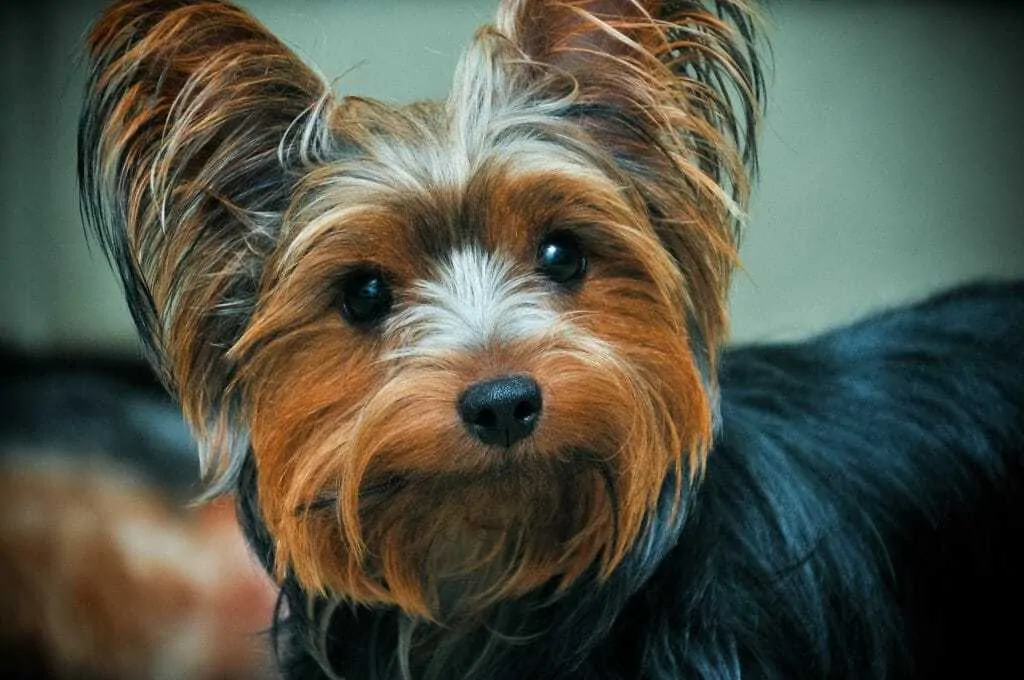
The Yorkshire terrier is the No. 1 toy dog breed in the U.S., beloved for its good looks and spunky personality.
No review of the terrier breeds would be complete without mention of the diminutive Yorkshire Terrier. Standing just 7 inches tall and weighing around 7 pounds, these tiny dogs are small in stature but big on attitude. Playful, spunky and always willing to take on a challenge, they have personalities that belie their tiny size. They are also quite attractive, whether their silky blue-grey and tan fur is left long or clipped.
Popular with jet-setters and urban dwellers across the globe, Yorkies are also well suited to family life. That said, they are too delicate to live in a home with small children, who may not understand that the cuddly little bundle of fur they love so much is not a toy. They are good with older children, however, and also make great pets for seniors because their exercise needs are fairly low.
Yorkies are prone to a few minor health issues, according to PetMD. These include patellar luxation and Legg-Calve-Perthes Disease, a painful hereditary condition in which the head of the femur (the long bone that connects the knee to the hip) loses its blood supply and eventually begins to die. Dogs afflicted with this condition usually need surgery to correct the disorder to live normal, healthy lives.
The Bottom Line
Obviously, terrier breeds are a diverse and eclectic group of dogs. But they do share many attributes, not the least of which are their high intelligence, high energy and a (sometimes infuriating) stubborn streak. Yet, with proper care and socialization, all terriers can be wonderful companion dogs and, with the exception of a few breeds that don’t do very well with young children, great family pets.

Jen Jones is a professional dog trainer and behavior specialist with more than 25 years of experience. As the founder of ‘Your Dog Advisor’ and the ‘Canine Connection’ rehabilitation center, she applies a holistic, empathetic approach, aiming to address root causes rather than merely treating symptoms.
Well known for her intuitive and compassionate approach, Jen adopts scientifically-proven, reward-based methods, encouraging positive reinforcement over punishment. Jen specializes in obedience training, behavior modification, and puppy socialization. Her innovative methods, particularly in addressing anxiety and aggression issues, have been widely recognized. Jen has worked with many of the world’s leading dog behaviorists and in her free time volunteers with local animal shelters and rescue groups.
